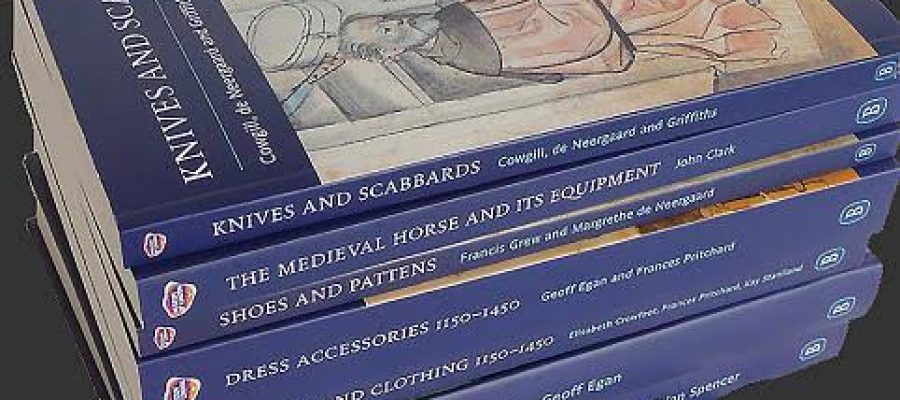Good books are essential to good living history, and it is my belief that building a modest material culture library will pay dividends for a lifetime in the hobby. Books are far more than just the accumulation of abstract knowledge with no real-world application. Our hobby is predicated on realizing that knowledge in the form of tangible objects and books are the primary way to that end. They should be viewed as an investment directly into our kits, not as an expense to be avoided in favor of putting money toward stuff. There’s no way around it though, some books can be expensive. Books about specialized topics in limited print runs can be two or three or ten times more expensive than what people imagine a book should cost. It’s no wonder I see a lot of people balk at the price of a recommended book when they ask for a good one. The thing that’s important to understand though, is that these books are every bit as essential to our kits as the reproductions we make or buy as the former almost always plays a significant role in the quality of the latter, even when you have no intention of making the item yourself. The good news is that not all of the books that benefit our hobby are going to break the bank. There are plenty of high-quality affordable books out there that are every bit as valuable as the high-dollar ones – the Museum of London series comes to mind as do many of the readers published recently by the Royal Armouries and the Met – but what’s troubling to me is that I often see just as much reluctance from people wanting to avoid investing in any books at all while being all too eager to throw their money at bad kit.
The first thing I want to get out of the way is that I’m not talking about predatory third-party booksellers that try to gouge people on out-of-print books and mark up the price of some hard-to-find volume to $1999.00 for something that normally carries an MSRP of $50.00, that’s not the topic here. There are much better ways to find used books. Places like bookfinder.com are much more effective than going directly to a storefront like eBay or Amazon if you’re looking for something old. There are of course certain books that are just going to be difficult to find or completely inaccessible due to rarity or other factors. Like I said though, these aren’t the books I’m talking about.
The pricier books in our hobby are usually expensive because they’re often printed by small academic presses, or specialized publishing houses that simply can’t print in the volume of your standard mass-market paperback when you consider how small the intended audience is. The important part to understand here is that there’s no replacement for the information in a good book. Every single piece of material culture we make, purchase, or commission is best informed by the quality information found in a vetted publication, written by a qualified individual or group of individuals. Internet groups and YouTube videos only give you part of the story if the information is even accurate to begin with. There’s a whole lot of absolute crap to wade through that can easily steer the newcomer in some very wrong directions. This is not to say that anything printed on paper is somehow more valuable or more correct. Not all books are created equal, but the vetted, tried-and-true books out there are invaluable and really pay for themselves over time.
You will find that books, even expensive ones, can save you money in the long run. Reenacting is not the most inexpensive hobby, and most of us do this on a budget, so I’ve never seen the value in spending money on things you know you’ll ultimately have to replace. So how do books save you money? If you want to make a pair of turnshoes, skipping the expense of tracking down a copy of Stepping Through Time is going to cost you more in just the materials you waste making shoe after shoe that doesn’t quite look right or doesn’t function at all. Even if you have no intention of ever putting needle to leather, being familiar with the actual breadth of finds published in the Museum of London’s Shoes and Pattens makes you a much more informed consumer. You will know what to look for when purchasing a pair of period footwear. You will give yourself the ability to discern between a low-quality pair of vaguely medievalish shoe-shaped objects and a quality turnshoe produced by someone who knows how to tunnel-stitch a heel stiffener into an upper properly. Even if you don’t opt for the most expensive pair of authentic shoes on the market, you will at least understand what the compromises are in the product you do choose to purchase and can convey this to the people you encounter at a living history event. Everyone in the equation becomes more informed and that’s a good thing. What you want to avoid is buying kit first and information second, only to realize that you have wasted money that could have been put toward the thing that would have given you longevity.
Now consider the really big purchases… like armor. If you’re about to consider selling a kidney to finance a shiny new harness, don’t you want to make sure you’re putting that money in the right place? You’ve only got two kidneys! I can’t tell you how many times I’ve seen someone willing to spend thousands of dollars on new armor but do everything in their power to avoid spending $50 or $100 on the one book that would help ensure that those thousands of dollars are well spent. It’s not enough to throw large sums of money at even the most talented craftsmen. An educated consumer is every bit as important as an educated armorer. I’ve seen the best armorers forced into the position of having to make bad armor at the insistence of their clients. Don’t be that guy. There is also the consideration of having to properly interpret that armor for the public if you do that kind of living history.
One of the best pieces of advice I can give to any reenactor is to start building up your material culture library (just forget I gave you this advice when you develop your inevitable book addiction). There are inexpensive books to get you started that punch well above the weight their cover prices suggest, but eventually you will want to consider even some of the pricier ones. Re-frame the way you think about books. They are not an ancillary expense that nets no tangible value, they are investments that get you closer to the ultimate goal of a good kit. A library will serve you for a lifetime and help you with all aspects of your kit from the most mundane objects to the most grandiose. The next time you want to buy a period buckle or strap-end for a belt but have no idea if the one you’re eyeing on the web is period correct, don’t purchase in the blind, reach for your copy of Dress Accessories. Interested in making a period sheath for your knife? Look up an appropriate style and construction in Knives and Scabbards. Your library will make you a better craftsman, a more informed consumer, and a better reenactor in the long run.






Leave a Reply